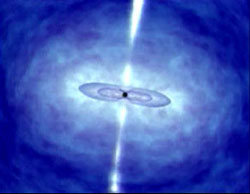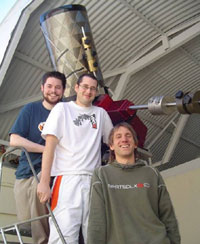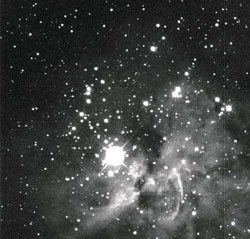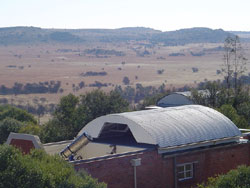UCD telescope captures early images of gamma-ray burst
A mere 19 seconds after receiving the coordinates of a gamma-ray burst from NASA's Swift satellite on May 26th, the UCD 'Watcher' robotic telescope in Boyden Observatory, South Africa, automatically began observations. The UCD telescope was the first to respond to the alert recording observations just 36 seconds after the explosion. Other telescopes from around the world also recorded images after receiving the coordinates via the internet but not as soon as the UCD telescope.

The collapsing star scenario is one of the leading contenders as the cause of gamma-ray bursts. Dr. Stan Woosley of the University of California at Santa Cruz proposed the collapsar theory in 1993. This artist's concept of the collapsar model shows the centre of a dying star collapsing minutes before the star implodes and emits a gamma-ray burst
that is seen across the universe. Credit: NASA/Dana Berry
PhD student John French was sitting at his computer in the UCD School of Physics when the telescope began taking images of the explosion. He immediately began downloading the images onto his computer. ‘The data arrived thick and fast from Watcher and the other telescopes. We already know that the afterglow behaviour is peculiar and we are working hard to interpret it. The burst occurred when the universe was roughly two billion years old’ says French.

UCD research students Gary Melady (left) and John French (centre) along with collaborator Petr Kubanek who is based in Geneva (right) with Watcher during its commissioning in March this year.
Gamma-ray bursts (GRBs) are immensely powerful bursts of high-energy radiation that can occur when a star collapses. They are by far the most brilliant sources in the universe and occur roughly once per day and can last from about 30 milliseconds to one thousand seconds.

A Watcher image of the massive star Eta Carinae. This star, with a mass more than 100 times that of our Sun, may create a gamma-ray burst in about 100,000 years, when it reaches the end of its nuclear fuel and detonates a supernova explosion
‘Detection of the visible light from GRBs is vital to advance our understanding of the physics of these explosive events, which are believed to be the sign of the collapse of very massive stars as they form black holes,’ says Watcher principal investigator, Lorraine Hanlon, UCD School of Physics.
'We are now in the process of piecing together the detailed physics of this burst and its afterglow, by combining the x-ray and gamma-ray data from the Swift satellite with the Watcher data’ continues Hanlon. ‘Watcher is part of an international network of robotic telescopes and our goal is to expand the number of such telescopes around the world to ensure continuous coverage of the sky.'

Watcher robotic telescope in Boyden Observatory, South Africa
Watcher began commissioning operations in late March 2006 and had only started its routine scientific observations just a few weeks before recording visible light from the recent gamma-ray burst. It is the first exclusively Irish research telescope at a high-quality astronomical site. Funded by UCD and the Irish Research Council for Science, Engineering and Technology, Watcher is operated in collaboration with physicists at the University of the Free State in Bloemfontein, South Africa.
